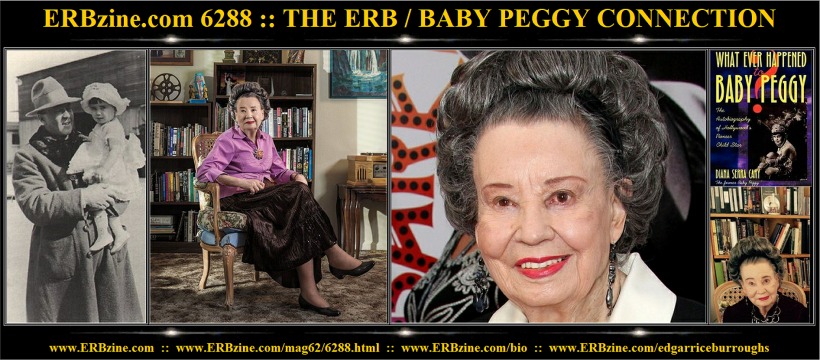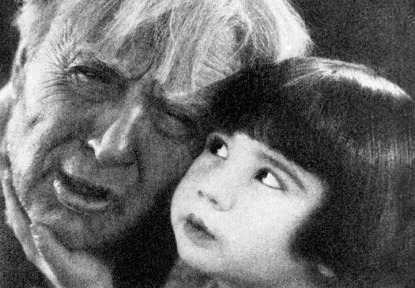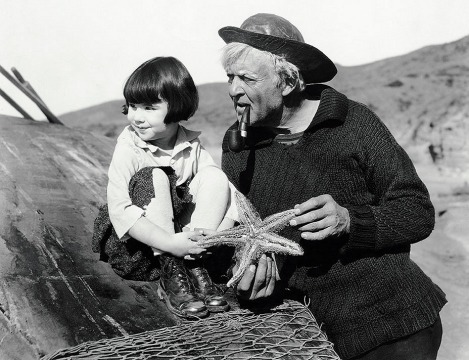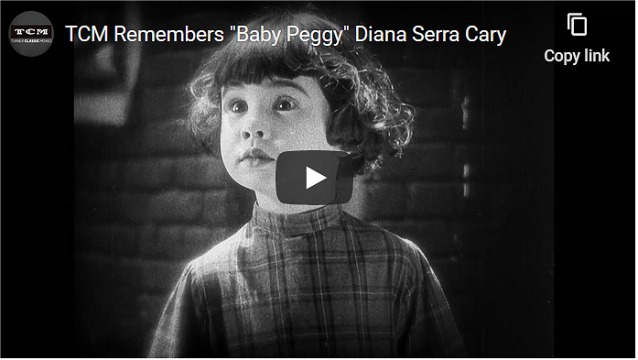
Official Edgar Rice Burroughs Tribute and Weekly Webzine Site Since 1996 ~ Over 15,000 Web Pages in Archive Presents Volume 6288 |

Official Edgar Rice Burroughs Tribute and Weekly Webzine Site Since 1996 ~ Over 15,000 Web Pages in Archive Presents Volume 6288 |

|
|

Essay by Rebecca Peters A decade before Shirley Temple there was Baby Peggy, one of the biggest child stars of the silent era. Born Peggy-Jean Montgomery in 1918, she began her film career entirely by chance at just 19 months old. Her father Jack Montgomery, a former cowboy and horse trainer, moved his family to Los Angeles and found work as a stunt-double for western star Tom Mix. One day Peggy’s mother, with children in tow, visited Century Studios on Sunset Boulevard’s Poverty Row, and when director Fred Fishbach came across the dark-eyed, curiously self-possessed Peggy, he knew he had found his costar for Century’s own Brownie the Wonder Dog.
Silent Film OrgAt the end of five days’ filming, Century Studios signed the toddler to a seven year, $300-a-month contract. Soon she began starring in her own Baby Peggy Comedies, an incredibly popular series of two-reelers that parodied fairy tales, novels, current Hollywood films, and grand opera.
Audiences marveled that two-and-a-half-year-old Baby Peggy, who played satirical adult roles, both male and female, was able to perform these parts, including takeoffs of Rudolph Valentino and Pola Negri. Her father, who had difficulty accepting that his baby daughter had become the family breadwinner, took credit for the Baby Peggy phenomenon. An expert trainer of horses and dogs, Jack Montgomery applied his belief in absolute obedience to his daughter. He insisted on supervising Peggy on the set, directing her with hand signals and spoken commands. Baby Peggy herself deserves credit for bringing her own instinctive touches to the performances.
Turning out these two-reelers, dubbed “Five-Day Wonders,” was not easy. Her eight-hour workday, six days a week, started at 7 a.m. with no time for the nap now required by California child labor laws. Scripts called for location shooting and increasingly put Baby Peggy in dangerous situations, from being dunked in ten-foot waves to nearly being tossed from a speeding truck. Surrounded only by adults, Peggy assumed that all children supported their parents, and by age three she sensed that the family’s fate — and improved lifestyle — depended on her. She viewed the child on-screen as a separate person, initiating a psychological detachment from Baby Peggy that endured until adulthood.
The Peggy-Jean Corporation moved to Universal Studios in 1922, and Peggy was guaranteed roles in feature-length films that emphasized melodrama over comedy. Her continuing box-office success put her in the same league as another contemporary child actor, Jackie Coogan.
In 1923, she became a “Million Dollar Baby” when producer Sol Lesser of Principal Pictures signed her to an extraordinary $1.5 million contract. With money and fame came personal appearances, magazine covers, international fan mail, Baby Peggy dolls, and Baby Peggy look-alike contests. In 1924, she was chosen as mascot for the Democratic National Convention and appeared at a rally in Madison Square Garden with Franklin Delano Roosevelt.
Captain January was the first film she made under the terms of her new contract; she starred in just one more feature for Sol Lesser, Helen’s Babies (1924), before her career took a series of disastrous turns. Her step-grandfather, who had also been her business manager, absconded with every penny of her earnings. Jack Montgomery’s bitter arguments with producers succeeded in getting Baby Peggy blacklisted from studios, and her last starring role, The April Fool (1926), was filmed on Poverty Row. Unable to relinquish their stake in Baby Peggy, her parents dragged her on an arduous vaudeville tour.
In the mid-1930s, Peggy enrolled in a school for professional movie children attended by child stars Judy Garland and Mickey Rooney and appeared in bit parts well into her teens under her full name, Peggy Montgomery. Never addicted to fame, she took advantage of hard times to escape her Baby Peggy alter ego. She discovered a love of writing and selected the new name of Diana for herself, because it sounded suitable for an adult with serious literary ambitions. She later added “Serra” — after Franciscan priest Junipero Serra — as her confirmation name.
Following an ill-fated marriage to a former child actor, she worked as a switchboard operator, freelance journalist and used-book clerk, and founded a greeting card company in Santa Barbara where she met and married artist Bob Cary. Deciding to reconcile with her past, she became a “film archaeologist,” authoring several notable books on silent film history, including Hollywood’s Children and The Hollywood Posse. Many of the Baby Peggy films, which number more than 40 shorts and nine features, have been lost. A few of her Century comedies survive in foreign archives and at the Museum of Modern Art in New York, and the Library of Congress has preserved Helen’s Babies and the print of Captain January being presented today. Two other features, The Family Secret and The April Fool, are commercially available from Grapevine Video.

The Bookseller Who Became an Author and
Who Once Had Been the Biggest Little film Star in the World
Ref: Huffingtonpost.comDiana Serra Cary spent nearly forty years working in bookstores in California and Texas. She was a clerk and head buyer, and worked the floor hand-selling books to customers back in the day before computerized inventories and when store staff had to know their stock. She also helped build a couple of small shops into major bookstores. Beginning in the late 1940s, she worked at a succession of stores including the Post Oak and Sam Houston bookstores in Houston and the Santa Barbara Mission book and gift shop in California. In 1991, after 20 years on the job, she retired from the UC San Diego student bookstore. A couple of her books were written while she was working as bookseller.
For a time in the 1920's, she along with Jackie Coogan was one of the two most famous child movie stars in the world. She was known then as "Baby Peggy." Her likeness regularly appeared in newspapers and on the covers of magazines. Sheet music and postcards pictured her, and Gimbels, the famous New York City department store, even modeled a doll after her. She went on personal appearance tours, endorsed products, and met celebrities like Tarzan author Edgar Rice Burroughs (who is pictured here holding the child actress in his arms). There would even be editions of children's books published which put her image on the cover in the hopes of selling more copies.
She was a celebrity then, the Shirley Temple of her time. She was so famous that as Baby Peggy she was named the "convention mascot" at the 1924 Democratic National Convention. There is a picture of the child actress standing near the future President, Franklin D. Roosevelt, on the convention stage. It was from such heights that this pint-sized star fell. At the age of 4 1/2 she was signed to a remarkable $1,500,000 contract. (Her co-stars included the likes of Clara Bow, Irene Rich, Edward Everett Horton, Hobart Bosworth, and other major names.
However, by the age of 6 it was all over. The film career of Baby Peggy abruptly ended in 1925 when her father had a falling out with studio executives over her contract. For the next four years, she worked in vaudeville. In the 1930s, a little more grown up, she returned to Hollywood and worked as an extra and bit player. As with Jackie Coogan, all her money had been squandered -- and not by her. The actress' final screen appearance was an uncredited role in Having Wonderful Time (1938), which starred Ginger Rogers, Douglas Fairbanks Jr., Lucille Ball, and Red Skelton. In 1948, looking to make ends meet after her divorce, the one-time actress landed her first bookstore job. It was in a small Los Angeles shop. In a recent interview, Cary explained she was drawn to this line of work because she loved books and had always been a voracious reader.
Ref: Hollywood Reporter ~ January 4, 2018


Former Child Star Baby Peggy
Self-Publishes Her First Novel at 99
The silent-film era actress marked her recent birthday with the publication of an "epic tale"
set in "the fascinating Mexican-American colonial Empire of New Spain" that centers on a woman facing the horrors of civil war.Diana Serra Cary — born on Oct. 29, 1918, and best known by her stage name Baby Peggy — was one of the most well-to-do child stars of the silent film era thanks to a seven-figure contract signed at age 4.
Cary recently marked her 99th birthday by self-publishing her first novel, The Drowning of the Moon, a tome that follows her memoir and a biography of fellow child star Jackie Coogan. Cary says the "epic tale," set in "the fascinating Mexican-American colonial Empire of New Spain," is about a woman named Sirena facing the horrors of civil war.
Cary, who says she writes in four- to five-hour spurts, is enjoying her age but has no plans of a full-on retirement. "[Life] is still productive, filled with today's crazy politics and wonderful scientific discoveries about nutritious food and good health. I'm thriving on the good life of the latter!"
The Hollywood Reporter caught up with Cary via email to learn more about Drowning of the Moon, her proudest career achievement and where she finds most joy in her life these days.
Congratulations on your new book — your first novel! What inspired you to write this book?
Historically, before the movies made Hollywood world famous, its major tourist attraction during the 1920s was the “romantic ruins” of its 18th century “Spanish Mission Period.” As a child of 3 I worked inside the ruined San Fernando Mission (which was then a studio location) and I was inspired by its colorful history. My book is set in the fascinating Mexican-American colonial empire of New Spain.
How do you describe it?
My book is a classic “historical novel," not the new style “historical romance." Its protagonist is a self-assured young noblewoman of a silver-mining dynasty, growing up in Guanajuato, a city of palaces in the mountains of northwestern colonial Spanish Mexico. The book begins with the milestone of her christening in 1756.
Is there a character you most identify with?
Despite the fact that our lives and times differ so greatly, I naturally identify with the challenges of my protagonist, the First Countess of the noble house of Graciana.
Who is your favorite author? What is your favorite book?
As a historian I have favorite authors in several disciplines. For nonfiction works on early Hollywood I recommend Scott Eyman. In Spanish-American history, among several highly readable scholars, I favor Eric Van Young, who most recently wrote the first biography of a famous 19th century Mexican historian, Lucas Alaman.
Describe your writing process. How many hours a day do you write? How long did it take you to finish this?
I really enjoy writing, Once I start a book, I work as long as four to five hours at a time, provided I have no other pressing commitment. In the case of my long historical novel, in 1957 I took a few days off from my job as manager of the general book department of the University of California’s San Diego campus bookstore, to visit what was then Mexico’s nearly abandoned city of Guanajuato. There I met Senor Manuel Leal, a fascinating descendent of a noble family who told me the story of the devastating destruction of the gracious silver mining society that was destroyed by murderous rampaging mobs during the ruthless outbreak of the Hidalgo Insurrection of 1810.
You recently turned 99 years old. Happy belated birthday! How did you celebrate?
Very happily with my son, Mark, and my 19-year-old granddaughter, Stephanie, who was visiting from her second year at Sacramento State.
Some people might say, "You're 99 years old, why keep working and writing?" What would you say to that?
Like many other retirees, for the first time I am now able to fully enjoy having the time for the rewarding work of my writing, after several stressful careers as a movie child star, bookseller, film researcher, public speaker, historian of Western Americana and published author of four nonfiction books on little-known aspects of Hollywood history. I was also the lucky wife of a gifted artist husband, during a happy marriage of 48 adventurous years.
Looking back at your writing career, what book are you most proud of?
I’m proudest of my biography of Jackie Coogan, partly because it was so difficult to write. I knew him as a child, and concentrating on his rather loveless real life offscreen with his self-centered parents made revisiting his childhood a painful task for a writer. However, I found amazing surprises after he reached his teens. The book’s public critics have all praised it.
How did you spend the holidays?
I have a number of lifelong friends from early Hollywood who call or visit me, and I still receive a steady stream of fan mail from all parts of the world. There are also a few old fans, now in their 90s, who remember enjoying my comedies and features in their childhood. Most surprising are the many young fans in their teens and 20s who love watching classics from the silent era as valuable and informative entertainment.
What brings you the most joy these days?
Being safely settled under my own roof, in my own home, with a loving, growing family around me. My son Mark got remarried recently and now has his new wife, Sofia (Fifi), and 12-year-old stepson Noah, living in the house. It is nice having the care of a loving family around me. Survivors like me have too often outlived all their relatives. My Baby Peggy fans write personal letters, asking for autographed stills and telling touching stories about how much she contributed to their happiness as children, something I had never dreamed of. They make my 99th year a very busy, contented place to enjoy memories of an incredibly adventurous life. I live near the century-old Broncho Billy museum and theater. We attend their fascinating Niles Silent Film Festivals as often as possible, where I meet new fans and old “in person” as often as possible.
Baby Peggy was the pioneer child star. Unfortunately, most of her movies were destroyed in an effort to save money and be able to reuse the expensive material used to make them so she isn't as well known as other child stars. Her parents squandered her money, and she was supposedly washed up by the time she was 16, but don't expect a bitter old woman. She's very positive and knows how to weave a story. I will be moving on to her book on other child stars next!

Baby Peggy and Hobart Bosworth in Captain January

Amazon Review Excerpts
(See the Amazon site for credits and for more reviews)
During the 1920s Baby Peggy Montgomery and Jackie Coogan were the most popular child stars in the movies. Coogan is long gone, but Baby Peggy lives on in the person of Diana Serra Cary. Ms. Cary is one of our foremost film historians, and her vivid narrative style allows us to stand right next to her as she relives her often-troubled youth in and out of the spotlight. We follow her from the early comedies at the ramshackle Century Barn to the newly formed Universal Pictures Studio. We see her star fall in movies and rise in vaudeville when she headlines at the famed Palace Theatre on Broadway. We are also privy to the highs and lows of her personal life, right up to the present day. How fortunate we are that so long after the demise of the silent era we have an eloquent survivor to represent it.
Diana Serra Cary's autobiography is both hauntingly sad and extraordinarily uplifting. The author writes with candor and authority, and as she tells the story of her life from her days as child star Baby Peggy in the 1920's to the present she draws the reader into a spellbinding tale that an author of fiction would have a difficult time fabricating.
As Baby Peggy, she enjoyed a huge public following that rivaled even that of Shirley Temple a decade later, but such fame for a very young child came at a huge personal price. A product of a highly patriarchal family, Peggy quickly realized that her life revolved around the whims and expectations of her mercurial father. As her star rose, he, in a series of bad decisions, undermined her and by the middle of the decade her film career was over.
In the life stories of many child stars, this would have been the end of it, a precursor to years of familial bitterness and impoverishment, but Peggy's father doggedly pursued continued fame for his child and, in consequence, more money and power for himself. Peggy was also an exceptionally intelligent, resourceful child. So after films fell apart, they hit the vaudeville circuit. What ensued was a difficult life that Cary describes in heartbreaking detail. Vaudeville, too, was short lived, and as Peggy emerged from this phase of her life her story becomes incredibly complex and unpredictable. Her family spends idyllic time on a ranch, but her father loses the land and they return to Hollywood in the 1930's. Peggy, now a young teenager haunted by her former life as Peggy Baby, endures agony and abuse by the studios, columnists, and, worst of all, the public. At a photography shop, a clerk asks her how it feels to be a has-been at 16. The book goes on to detail Peggy's metamorphosis into the self-assured, gifted writer and historian Diana Serra Cary, but the pain she goes through to get there is astounding.
When I first read this book in 1996, at the time of its first publication, I was enthralled by the early chapters describing Baby Peggy in early Hollywood. Rereading it now, upon its reissue as a paperback, I have been most enthralled by the later chapters, from the time of her bitter return to Hollywood in the 1930's forward, through the second world war and beyond. I simply could not put this book down. It is as intelligent and erudite a film autobiography as I have ever read, perhaps even the finest, and as sad as much of it is (there are times when I wanted to toss the book across the room in enraged exasperation at the deeds of her father) it is finely woven and brilliantly written, flawlessly constructed and brimming over with page after page of fascinating details and anecdotes. It is also at times hilariously funny.
I believe that I can safely say that one does not have to be a film buff to come away stunned and deeply affected by this book. It is indeed a story of the dark side of the entertainment world of the day; but, it is also a ferociously intelligent contemplation of a woman's deep longing to find identity in a world that is for the most part merciless in its treatment of her, a writing that is universal in its appeal.
Modern former child stars give impassioned interviews telling of their harrowing lives of early fame, blaming their parents and the world for their problems. None of them come close to the insight that Diana Serra Cary reveals in her own story. Amazingly, she does not seem to judge her father for the circus life he put her through. She does not pull punches in telling her harrowing tale, but at the same time there is no sense of condemnation. It is a story of acceptance and of dealing the best one can with the trials of life. It is a remarkable achievement.
The book concludes happily, or as happily as reality allows any story to end. By the final chapter, present day Diana has reconciled with her alter ego Peggy and has found that life for her is best lived as a swirl of them both. Inner peace, success, a happy family of her own, and a cult following spanning the globe are her well-earned rewards for a life spent so tumultuously. The reader closes the book, sorry to have come to the end but cheering loudly for its author and rejoicing in her ultimate triumph.
In all ways, Whatever Happened to Baby Peggy? is splendidly realized. It is an important contribution to film history, but it is also, simply put, a terrific and powerful read.

Visit the Baby Peggy Website
https://babypeggy.com/
Obituary ~ Filmography
~ Bio
TCM Remembers Baby Peggy on YouTube
https://youtu.be/ibcvdUEXSik
More in the ERBzine.com
Eclectica issue of July 2010:
www.erbzine.com/mag22/2289.html
![]()
![]()
![]()
![]()
![]()

![]()
BILL
HILLMAN
Visit
our thousands of other sites at:
BILL
and SUE-ON HILLMAN ECLECTIC STUDIO
ERB
Text, ERB Images and Tarzan® are ©Edgar Rice Burroughs, Inc.-
All Rights Reserved.
All
Original Work ©1996-2020 by Bill Hillman and/or Contributing Authors/Owners
No
part of this web site may be reproduced without permission from the respective
owners.